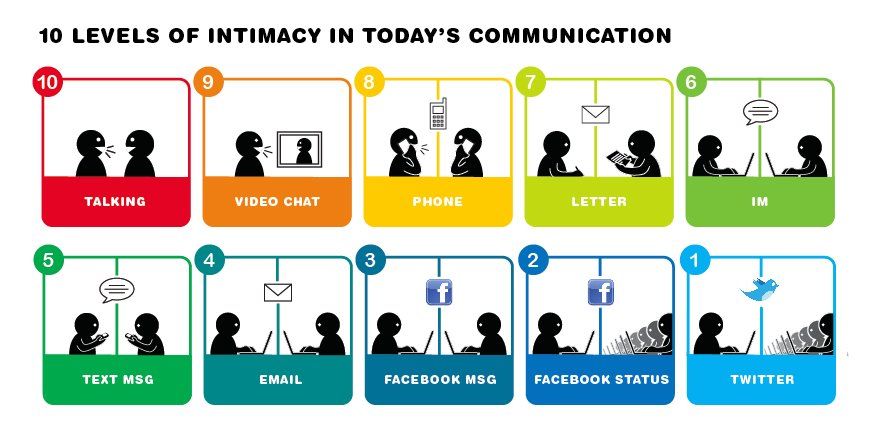Levels of Intimacy
Texting is the primary way people screw up their relationships at the start. Why, and what to do about it?

Intimacy can be scary. To allow an other to truly see us, our weaknesses, our fears, our desires, our dreams, our judgements, our anger, the places we think we’re not good enough... requires a certain kind of courage, the courage to let your guard down. Many say they are committed to transparency, but sometimes it’s hard to walk your talk!
We guard our vulnerability for a perfectly natural reason: We don’t want to experience what might happen if we did not. It might seem overwhelming, even dangerous to be truly transparent — that is, to be intimate. The fear of intimacy isn’t merely conceptual, it’s somatic. It’s a fear of a certain level of intense sensation in the body. Unfortunately, that fear, largely unconscious, prevents the development of the intimacy that many people truly want. Developing intimate connections requires being with that seemingly overwhelming level of intensity.
Somatic excitement can manifest as many things: anger, sadness, joy, turn on, fear, and so on. But at a somatic level it’s really just excitement. An unwillingness to experience excitement in one domain affects other domains, as well. For example, if you are stuck when it comes to expressing anger, your ability to experience joy will be correspondingly diminished.
Let’s review some of the strategies people use to avoid the somatic intensity of intimacy.
- Refuse to take responsibility. If you are having a conflict and you know you’re partly responsible, don’t admit it!
- Focus on differences. It’s important to acknowledge differences, but it’s also important to appreciate the things we have in common. By focusing on what doesn’t work you can narrow the conversation to a range that doesn’t threaten to expose your vulnerability.
- Be right. Maintain the rightness of your position at all costs. Make sure your partner understands that accepting your interpretation of events is required if they want to stay in communication with you.
- Stay busy! De-prioritize the other person by asserting that other things (work, family, etc.) are simply more important. That allows you to cast their efforts to communicate as detrimental to your well-being, and thus unwelcome. Postpone meetings. Make vague plans that will be easy to cancel.
- Judge the other person. If you can label someone as undesirable in some way, then it’s easier to avoid intimacy. They are no longer a person deserving of your compassion and respect. You have made them into a kind of object, and thus easier to reject.
- Make yourself unattractive, physically or behaviorally. Acting like an ass-hat is a great way to discourage people from seeing who you really are, although, of course, it’s not without its cost!
- Withhold your true thoughts and feelings. By withholding the truth you can keep the other person off balance. You know something they don’t. This effectively stymies the communication that might lead to understanding, resolution, and intimacy.
I included the graphic above because it points to another way we regulate our level of excitement: choosing the mode of communication at which the excitement is manageable. If a phone call is too “exciting,” try an email or text message. The problem, though, is that the written modes of communication don’t allow for the kind of communication that leads to understanding and resolution. A large percentage of our meaning is communicated in nonverbal ways: tone of voice, facial expression, body language. A written message allows one to hide all of that, to hide the emotional truth. The consequence of manipulating your internal level of excitement is that your relationship stays stuck in whatever unpleasantness you are trying to avoid.
I believe that we have been taught to decrease the intensity of circumstance rather than increase the intensity of awareness. I have watched many enlightened people fall apart in the sexual arena or in the relationship arena so this is where I am interested in starting.
—Nicole Daedone
Note that although people most frequently avoid expressing the “less preferred” emotions, sometimes it’s really “I’m afraid to tell you how much joy I feel when I’m with you.”
If you recognize that you are avoiding intimacy, see if you can hang out with the discomfort a little. Can you move up to one of the verbal intimacy levels? If not, is it possible to at least take responsibility for the fact that you are feeling triggered and communicate that at the intimacy level you can manage?
Finally, it’s worth mentioning that if the person you are in conflict with is not able to meet you on the level of intimacy where you’d like to be met, be patient! They are doing the best they can.
In the workshops I lead we create a container for enhancing our ability to experience intense sensations (the good, the bad and the ugly!) in relationship with others. We become each other’s allies in cultivating that ability, which leads to more connection and intimacy. And that’s exciting!
